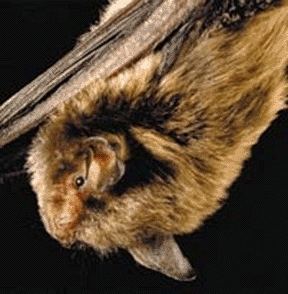Most of the many bat species found in the United States are insectivorous except for three flower eating species that migrate from Mexico.
Bats belong to the biological order of Chiroptera. The bat families found in North America are Vespertilionidae, Molossidae, Mormoopidae and Phyllostomidae.
Canyon bat Parastrellus hesperus
Eastern Pipistrelle Perimyotis subflavus
Big Brown Bat Eptesicus fuscus
Evening Bat Nycticeius humeralis
Western Red Bat Lasiurus blossevillii
Eastern Red Bat Lasiurus borealis
Hoary Bat Lasiurus cinereus
Southern Yellow Bat Lasiurus ega
Seminole Bat Lasiurus seminolus
Allen's Big-eared Bat Idionycteris phyllotis
Spotted Bat Euderma maculatum
Rafinesque's Big-eared Bat Corynorhinus rafinesquii
Townsend's Big-eared Bat Corynorhinus townsendii
Southwestern Myotis Myotis auriculus
Southeastern myotis Myotis austroriparius
California Myotis Myotis californicus
Western Small-footed Myotis Myotis ciliolabrum
Long-eared Myotis Myotis evotis
Gray Myotis Myotis grisescens
Keen's Myotis Myotis keenii
Eastern small-footed myotis Myotis leibii
Little Brown Bat Myotis lucifugus
Arizona Myotis Myotis occultus
Northern Long-eared Myotis Myotis septentrionalis
Indiana bat Myotis sodalis
Fringed Myotis Myotis thysanodes
Cave Myotis Myotis velifer
Long-legged Myotis Myotis volans
Yuma Myotis Myotis yumanensis
Silver-haired Bat Lasionycteris noctivagans
Wagner's Mastiff Bat Eumops glaucinis
Florida Bonneted Bat Eumops floridanus
Western Mastiff Bat Eumops perotis
Underwood's Bonneted Bat Eumops underwoodi
Pallas's Mastiff Bat Molossus molossus
Pocketed Free-tailed Bat Nyctinomops femorosaccus
Big Free-tailed Bat Nyctinomops macrotis
Brazilian Free-tailed Bat Tadarida brasiliensis
Ghost-faced Bat Mormoops megalophylla
Mexican Long-tongued Bat Choeronycteris mexicana
Hairy-legged Vampire Bat Diphylla ecaudata
Mexican Long-nosed Bat Leptonycteris nivalis
Southern Long-nosed Bat Leptonycteris curasoe
California Leaf-nosed Bat Macrotus californicus
Common Vampire Bat Desmodus rotundus
In 2009 the Grandview Mine in the Grand Canyon National Park had gates added to support on-going bat research, preserve historic mine resources, and promote visitor safety.
The Ann W. Richards Congress Avenue Bridge, which crosses over Lady Bird Lake in Austin, Texas, is the world's largest urban bat colony.
Seventeen species of bats live in the Carlsbad Caverns National Park, including a large number of Mexican Free-tailed Bats. It has been estimated that the population of Mexican Free-tailed Bats once numbered in the millions but has declined drastically in modern times. The cause of this decline is unknown but the pesticide DDT is often listed as a primary cause.
As of February 2011, at least three states had an official bat. Hawai'i named the Hawaiian hoary bat as the official state land mammal in April 2015. The general assembly of North Carolina considered a bill in 2007 that would have made Rafinesque's Big-eared Bat as its state bat. The bill passed 92-15, but died in the state senate.

